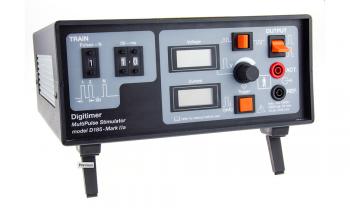D185 MultiPulse Transcranial Cortical Stimulator
The Digitimer D185 multipulse transcranial cortical stimulator delivers max. voltage up to 1000V, max. current up to 1.5A, pulse duration 50?µs; 1 to 9 pulses at a set interval. It's MDD CE certified and FDA cleared medical device.
- Overview
- Specifications
- Links
FEATURES
- Medical device MDD is FDA-approved and CE-certified.
- Maximum voltage output is 1000V (set by user).
- Maximum current output of 1.5A (LCD monitor).
- 0.1A per microsecond rise time.
- Pulse duration of 50 µs.
- 1 to 9 pulses, with an interpulse interval that is user-defined.
The D185 MultiPulse Cortical Electrical Stimulator is the ONLY standalone surgical stimulator with FDA certification for intraoperative monitoring (IOM) of the spinal cord, a method that is now widely used.
Transcranial motor evoked potentials (MEPs) can be employed in surgical operations like scoliosis correction, spinal tumor removal, and thoraco-abdominal aortic aneurysm (TAAA) repair thanks to the D185 MultiPulse Cortical Electrical Stimulator. MEPs can even be induced in individuals with pre-existing neuropathologies thanks to the 1000V power source.
Peripheral nerve stimulation is another application for the D185 MultiPulse Cortical Electrical Stimulator. The D185 was created for transcranial cortical stimulation during intraoperative monitoring, but due to its brief high voltage output, it can also be used to stimulate the spinal roots to help with the differential diagnosis of disorders of the peripheral nerves, such as multifocal motor neuropathy and motor neuron disease. The extremely brief pulse duration reduces patient discomfort while the high voltage successfully stimulates deep nerve roots as they leave the spinal column.
Who Needs Intra-operative Monitoring?
There is a chance of neurological impairment following surgery on the spinal column, close to the spinal column, or involving a temporary interruption of blood flow to the spinal cord (such as the repair of thoraco-abdominal aortic aneurysms). This neurological impairment can range from loss of sensation to total paralysis. These deficiencies may develop as a result of physical trauma, nerve strain, or blood flow obstruction. Therefore, much work has gone into creating methods that allow the spinal cord's condition to be monitored continually throughout these risky surgical procedures.
Sensory Evoked Potential (SEP) Monitoring
Currently, surgical teams use stimulation of the patient's ankle or wrist and observation of the changes in somatosensory evoked potentials (SEPs) obtained from the brain to assess the health of ascending spinal sensory pathways. There is no question that this method of intra-operative monitoring has saved many patients from medically induced neurological damage since it exploits changes in the SEP waveform to inform medical teams of potential difficulties. But there has been some criticism of the SEP monitoring method, much of which has been printed in peer-reviewed journals:
- On occasion, unaltered SEP waveforms have deceived surgeons into performing the procedure, leading to unanticipated post-operative neurological consequences such severe paraplegia.
- Surgeons have resisted doing operations because of altered SEPs, only to discover after the treatment that the patient had not lost any sensory function.
- SEPs are typically of tiny magnitude, making it challenging to reliably monitor them in some individuals, especially those who have a history of neuropathology.
Some contend that the descending motor fibers may be more vulnerable after surgery due to anatomical factors, even if SEP monitoring is employed as a measure of the spinal cord's overall health. This would imply that either exclusively or in conjunction with SEP monitoring, it would be extremely beneficial to monitor descending motor fibers.
Transcranial Electrical Motor Evoked Potentials (tceMEPs) & Digitimer Ltd
Digitimer created the D185 MultiPulse Stimulator in partnership with eminent clinical neurophysiologists to give a more dependable technique of decreasing the risk of medically caused paraplegia while maximizing the level of surgical correction that may be safely performed. With the use of this innovative tool, the motor cortex of the brain is electrically stimulated transcranially, causing a descending motor evoked potential (MEP) that travels through the spinal cord to the upper and lower limbs. The channels that are stimulated in this way are the same ones that the brain uses to initiate and regulate voluntary movement. Similar to SEP monitoring, any changes to the MEP waveforms might provide the surgical team a valuable heads-up about potential difficulties.
MEP Monitoring – The Way Forward?
The MEP monitoring during spinal surgery was shown to be (1) more accurate for predicting motor outcome than the SEP was for predicting sensory outcome and (2) that useful motor responses were achievable with a higher probability than useful sensory responses in a 1000 patient, 2 center clinical trial of the Digitimer D185 in the USA. A further use of MEP monitoring was demonstrated to more accurately indicate whether it was safe for the surgeon to perform a procedure in situations when SEP monitoring alone may have misled the surgeon into abandoning or limiting a procedure. The FDA approved the Digitimer D185 MultiPulse Stimulator for marketing based on evidence from the aforementioned 5-year trial, and cardiology and neurosurgeons all around the world now often use MEP monitoring.
You can also visit site of the manufacturer.


